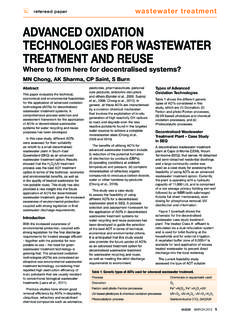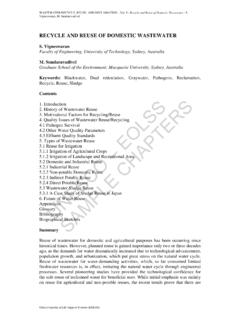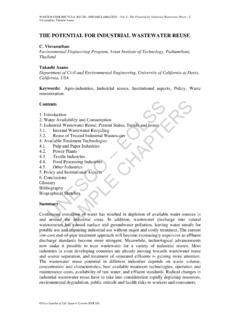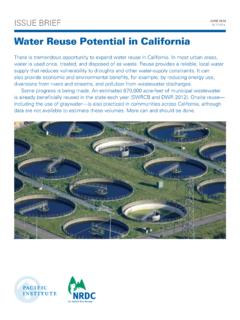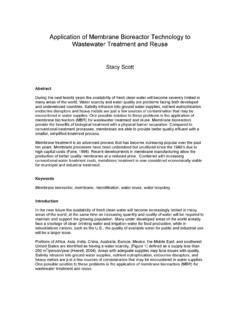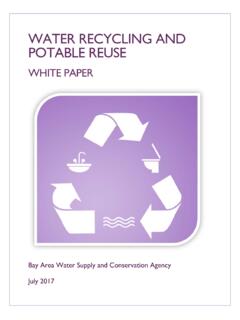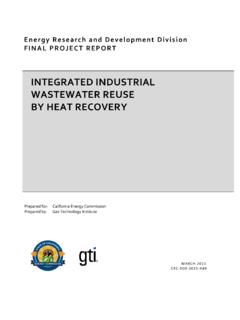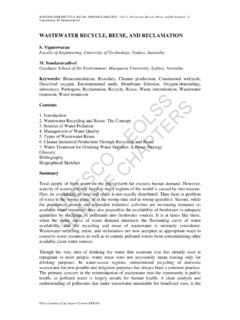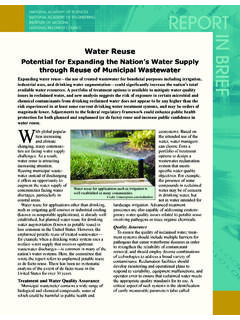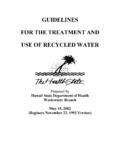Transcription of Briefing note: On-site wastewater treatment, recycling and ...
1 Briefing note: On On-- site wastewater treatment , recycling and reuse prepared by the NTUA. On-site water recycling and reuse systems involve reclaiming wastewater on site , as well as harvesting rainwater and distributing reclaimed water within the buildings for non-potable use. They have great potential as water conservation measures, and can also reduce the need for infrastructure expansion required for water distribution and wastewater collection. Although Making greywater blue there are some applications of such systems in the domestic sector, this approach to water conservation is still largely unknown and is consequently often overlooked as a possibility. Introduction Water reuse is the use of wastewater or water reclaimed less freshwater resources, reduce the amount of pollution from one application, such as clothes washing, for an- going into waterways and help save money on new other application, such as landscape watering.
2 Water infrastructure for water provision and wastewater recycling is a subset of water reuse , and involves re- treatment . Similarly, through collection and storage in using water for the same application for which it was rainwater tanks, roof rainwater run-off can be a valuable originally used. water source for flushing toilets, in washing machines, The traditional and prevailing concept in water supply watering gardens and washing cars, and therefore and wastewater treatment infrastructure is characterized contribute to significant fresh water savings. by open-loop design, involving centralized structures and mixed wastewater streams of various qualities. However, individual households, public and commercial On-site wastewater treatment and re- buildings and industrial facilities can each adopt their use methods own water supply and wastewater systems, based on on- There are two main types of domestic wastewater , site water treatment methods.
3 Rainfall can provide a blackwater and greywater. Blackwater is the term used source of potentially potable water supply. The to describe wastewater with high concentrations of fecal systematic separation of the various water and matter and urine. It is heavily polluted and difficult to wastewater streams can enable highly efficient treat because of the high concentrations of organic pollu- processes, and open the way for reclamation and reuse of tion. Greywater refers to all other wastewater generated water of various qualities. from domestic processes, such as washing dishes, laun- In the home, wastewater can be used to flush toilets, dry and bathing. It comprises 50-80% of residential water gardens, and in some cases even for clothes wastewater .
4 Washing. By using wastewater as a resource rather than a waste product, households can reduce water bills, use On-site wastewater treatment can be performed through: Septic tanks On-site aerated wastewater treatment systems Primary and secondary systems for greywater reuse Septic tanks Septic tanks treat both greywater (from shower, sinks and washing machines) and blackwater (toilet water). A. conventional septic tank system involves the under- Aerated wastewater treatment system ground installation of a tank made of concrete and an absorption trench. wastewater treatment is performed As shown in Table 1, wastewater treatment costs can through anaerobic processes, whereas the final treatment vary substantially, especially in the case of aerated sys- occurs via the absorption trench.
5 Tems. Table 1: Typical costs for On-site wastewater treatment Installation treatment sys- Maintenance Cost tem Cost (AU$/yr). (AU$). Septic System 4,300 - Aerated waste- 6,000-$8,000 $260. water system Primary and Secondary Greywater reuse Septic tank and absorption trench Systems If collected using a separate plumbing system to black- Septic tanks provide only limited treatment through the water, domestic greywater can be recycled directly settling of solids and the flotation of fats and greases. within the home and garden. Bacteria in the tank break down the solids over a period Recycled greywater of this kind is never clean enough to of time. wastewater that has been treated in a septic tank drink; however relatively clean greywater can be applied can only be applied to the land through the covered soil directly from the sink to the garden, as it receives high absorption system, as the effluent is still too contami- level treatment from soil and plant roots.
6 In such, pri- nated for above ground or near surface irrigation. mary systems, greywater is collected and directly dis- tributed by gravity, or a pump for subsurface irrigation. On-site wastewater treatment On-site aerated wastewater systems rely on mechanical devices that mix, aerate and pump the effluent. Subject to accelerated aerobic and anaerobic decomposition, these systems use one or two tanks. The treated water can be used for surface or under ground irrigation (the reuse of blackwater inside the home is not advisable, even after treatment and disinfection). A minimum irrigation area of 200m2 is usually required. Primary greywater reuse system In general, greywater storage and reuse requires treat- ment and disinfection, due to the presence of pathogens and other contaminants.
7 Through a number of stages of 2. filtration and microbial digestion in a secondary reuse hold uses, such as clothes washing and toilet flushing, system, greywater can be used for flushing toilets and without prior treatment . for underground drip garden irrigation. The design and installation of rainwater tanks involves defining: the location of the tank and its relationship to nearby buildings, tank capacity, dimensions and other structural details, and the purposes for which the tank will be used. Secondary greywater reuse system Table 2 provides installation costs for greywater systems, which can range from several hundred dollars to more than US$5,000. Costs depend on whether the system is to be installed in an existing or a new building, and whether the building has a raised or slab foundation.
8 Costs are usually lowest for new constructions and high- est for existing buildings with slab foundations. In fact, it is so expensive to install a complete greywater system in an existing home with a slab foundation that only efflu- ent from the washing machine should be considered in Residential rainwater tank connected to a top-up'. this situation. system providing rainwater for outdoor use, toilet flushing and the washing machine Stormwater & Rainwater harvesting Rainwater tank design should make provisions for: Stormwater is the term used to describe water that A minimum available volume, in order to ensure originates during precipitation events. Surface run-off that water supply is always available, from impervious surfaces, such as roofs, roads, A rainwater storage volume driveways and parking lots needs to be treated for use, as An air space for additional stormwater it is can contain pollutants originating from accidental management spills, leakages, materials handling practices or the application of chemicals (including fertilisers), or wastes In general, the size of the tank is determined by the deposited onto exposed areas.
9 However, rainwater purpose of use: collected in rainwater tanks is suitable for some house- For supplying all non-potable domestic uses (toilet flushing, clothes washing, garden irrigation and car washing), and for stormwater Table 2: Costs for greywater reuse systems System Type Greywater sources Technical Features Cost (US$). Low -tech owner or Washing machine 200 micron mesh filter 400. Sump pump to pvc tubing 1,000. Medium-tech All Subsurface drip irrigation 1,500. 200-micron mesh filter Automatically back-washed sand filter;. 250 gallon storage tanks; Pumps at Fully automated professional instal- 2,500. All both source and tank/filter; 3-way lation 5,000. valve, backflow preventers; Micro- processor controls all flows; Backed by 3.
10 Management, a minimum capacity of 5 m3 is systems and stream augmentation. In a water reuse pro- required. ject in the Shinjuku area of Tokyo, a dual distribution For toilet flushing and irrigating a small system has been adopted and sand-filtered water from garden a capacity of 2 m3 would be sufficient. the Ochiai Municipal wastewater treatment Plant is The roof should be large enough to collect the amount of chlorinated and used as toilet-flushing water in 25 high- water required. Gutters and downpipes are used to rise business premises and for stream augmentation, as maximize the amount of rainwater entering the tank. illustrated in the figure. The system, which has been suc- Rainwater tank overflows should be diverted to the cessfully operated since 1984, is supplying treated waste- stormwater system, if a separate system exists.

